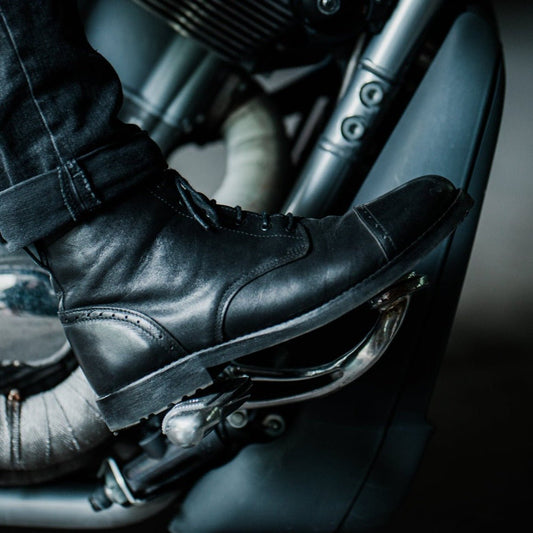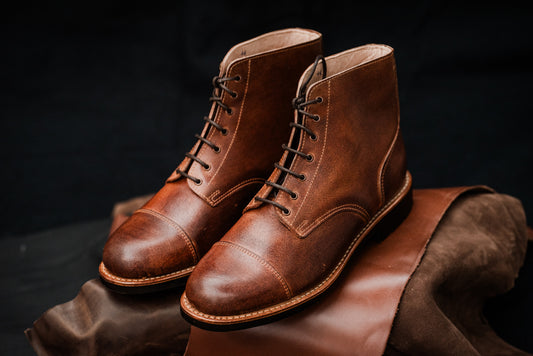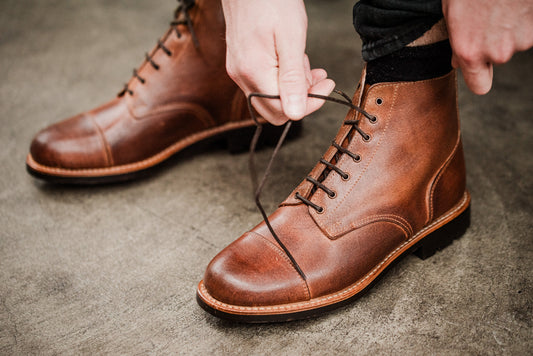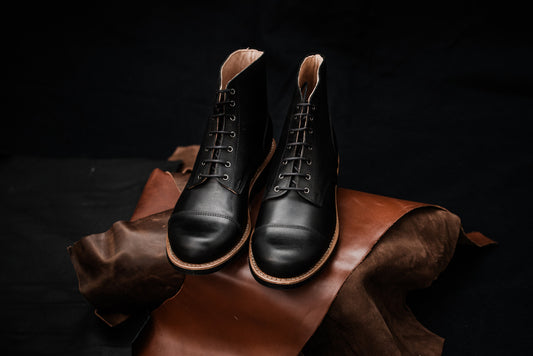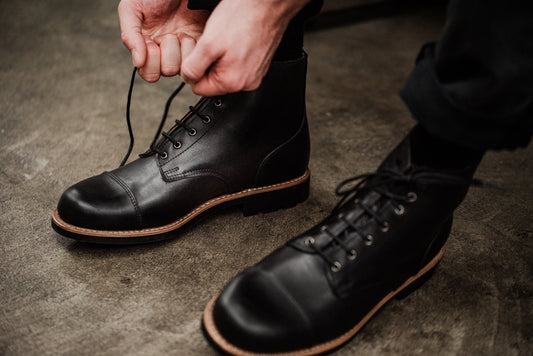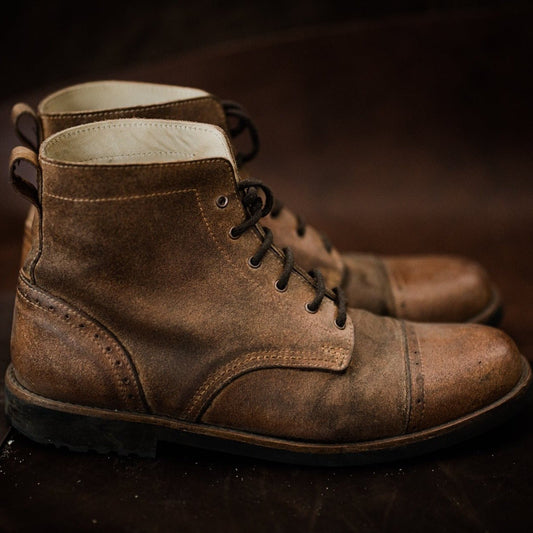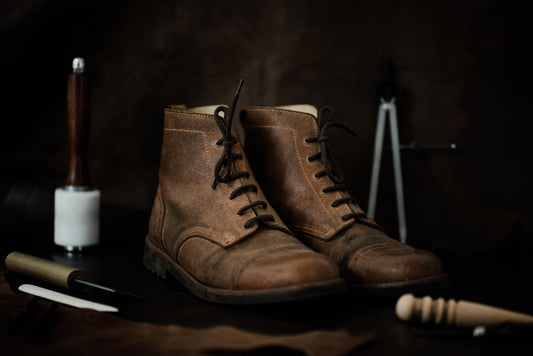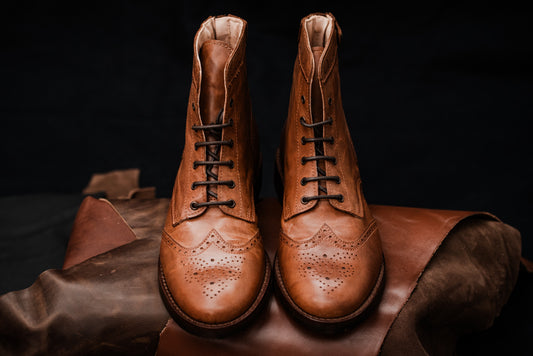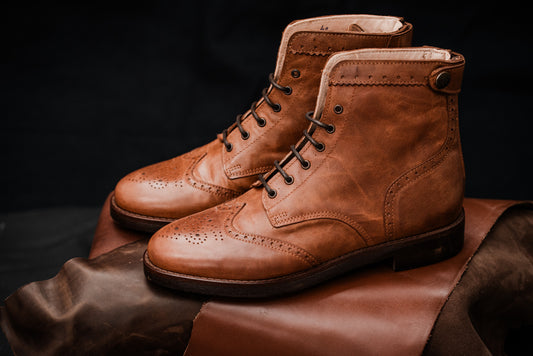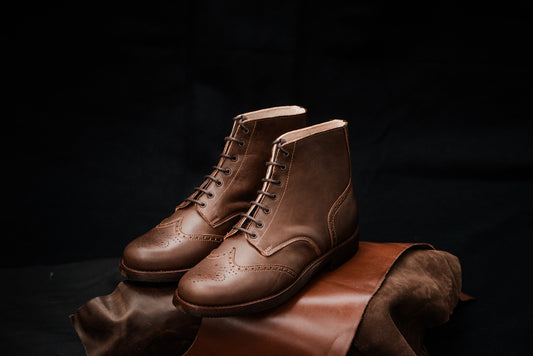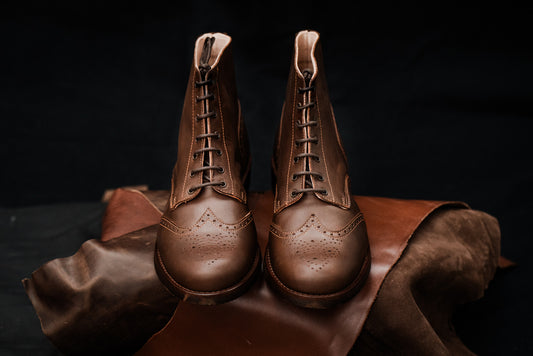Vintage-Stiefel für Männer: Ein umfassender Leitfaden für zeitloses Schuhwerk
Aktie
Wichtige Erkenntnisse:
- Einführung
- Geschichte der Vintage-Stiefel
- Arten von Vintage-Stiefeln
- Materialien und Konstruktion
- So stylen Sie Vintage-Stiefel
- Pflege von Vintage-Stiefeln
- Wo man Vintage-Stiefel findet
Der zeitlose Reiz von Vintage-Stiefeln in der Herrenmode
Wenn wir uns mit der Welt der Vintage-Stiefel beschäftigen, ist es wichtig, ihren tiefgreifenden Einfluss auf die Herrenmode zu erkennen. Diese ikonischen Schuhe sind mehr als nur stilvolle Accessoires; sie repräsentieren ein Erbe an Handwerkskunst und zeitlosem Design, das Generationen überdauert hat. Vintage-Stiefel haben sich dank ihres einzigartigen Charakters und ihrer Langlebigkeit einen Platz in der modernen Garderobe erobert.
Erbe und Handwerkskunst
Ein prägendes Merkmal von Vintage-Stiefeln ist ihre Herkunft und Handwerkskunst . Viele zeitlose Modelle, wie der Brogue oder der Chelsea Boot, haben Wurzeln, die über ein Jahrhundert zurückreichen. Jedes Paar erzählt die Geschichte der Handwerker, die es sorgfältig gefertigt haben, und unterstreicht die Langlebigkeit hochwertiger Materialien und Techniken. Dieses Streben nach Exzellenz führt dazu, dass Vintage-Stiefel oft in Würde altern und eine einzigartige Patina entwickeln, die ihren Charme unterstreicht und sie flüchtige Modetrends überdauern lässt.
Vielseitigkeit im Styling
Ein weiterer Grund, warum Vintage-Stiefel in der Herrenmode so beliebt sind, ist ihre bemerkenswerte Vielseitigkeit . Ob für einen formellen Anlass oder einen legeren Ausflug – für jedes Outfit gibt es den passenden Vintage-Stiefel. Kombinieren Sie sie mit maßgeschneiderten Anzügen für einen schicken Look oder tragen Sie sie lässig mit Jeans und einem schlichten T-Shirt für einen entspannten Look. Diese Anpassungsfähigkeit macht Vintage-Stiefel zu einer sinnvollen Investition in jede Garderobe, da sie mühelos verschiedene Stile aufwerten.
Nachhaltige Modeauswahl
In der heutigen klimabewussten Welt symbolisieren Vintage-Stiefel eine bewusste Entscheidung für nachhaltige Mode . Mit dem Kauf von Vintage-Schuhen gehst du nicht nur auf Geschichte ein, sondern reduzierst auch Abfall und die Nachfrage nach Fast Fashion. Mit Vintage-Schuhen kannst du deinen Stil zum Ausdruck bringen und gleichzeitig für umweltbewussten Konsum eintreten – ein modisches Statement, das wirklich zählt.
Einen persönlichen Stil entwickeln
Und schließlich trägt die Investition in Vintage-Stiefel dazu bei, einen persönlichen Stil zu entwickeln, der sich von anderen abhebt. Die unverwechselbaren Stile und Designs von Vintage-Schuhen ermöglichen es Männern, ihre Individualität und ästhetischen Vorlieben besser zum Ausdruck zu bringen, als es Massenware je könnte. Mit Vintage-Stiefeln tragen Sie ein einzigartiges Stück Geschichte, machen Ihr Ensemble zum Gesprächsthema und zeigen Ihre Wertschätzung für klassischen Stil.
Zusammenfassend lässt sich sagen, dass Vintage-Stiefel aufgrund ihrer zeitlosen Anziehungskraft, Vielseitigkeit und Nachhaltigkeit eine bedeutende Rolle in der Herrenmode spielen. Behalten Sie bei unserer weiteren Erkundung dieser klassischen Schuhe ihre reiche Geschichte und die Zukunft, die sie versprechen, im Hinterkopf.
Die Geschichte der Vintage-Stiefel
Die Entwicklung von Herrenstiefeln spiegelt eine vielfältige Mischung kultureller Einflüsse, modischer Entwicklungen und praktischer Bedürfnisse wider. Über Jahrhunderte hinweg haben diese langlebigen Schuhe nicht nur den Stil geprägt, sondern sich auch an die veränderten gesellschaftlichen Anforderungen angepasst. Im Folgenden untersuchen wir die wichtigsten Stile von Vintage-Stiefeln und zeigen, wie sie im Laufe der Jahrzehnte von verschiedenen Trends beeinflusst wurden.
Frühe Anfänge: Das 19. Jahrhundert
Stiefel waren im frühen 19. Jahrhundert vor allem funktional und für den harten Einsatz konzipiert. In dieser Zeit entstanden hohe Stiefel aus strapazierfähigen Materialien wie Leder. Männer brauchten während der Industriellen Revolution Schuhe, die den rauen Bedingungen standhalten konnten. Dies führte zu:
- Wanderschuhe – Entwickelt für Komfort und Ausdauer.
- Kavalleriestiefel – Beim Militär zum Reiten beliebt, gekennzeichnet durch ihren hohen Schaft.
Der Aufkommen des Stils: Frühes 20. Jahrhundert
Als Mode und Funktionalität immer stärker zusammenwuchsen, brachte das frühe 20. Jahrhundert eine Welle neuer Stile hervor, darunter Oxford- und Gummistiefel . Diese Ära markierte einen Wandel hin zur Personalisierung, bei dem Stiefel zum Ausdruck individuellen Stils wurden. Wichtige Einflüsse waren:
- Weltkriege – Die Nachfrage nach langlebigen Stiefeln trieb Innovationen voran.
- Hollywood-Stars – Schauspieler wie James Dean machten den Stil der Jugend populär.
Neuerfindung: Die Mitte des 20. Jahrhunderts
Die 1950er und 60er Jahre läuteten eine kulturelle Revolution ein, die die Herrenstiefel maßgeblich beeinflusste. Der Aufstieg des Rock ’n’ Roll trug zur Popularität ikonischer Stile wie dem Engineer Boot und dem Chelsea Boot bei. Soziale Bewegungen prägten den Geschmack und führten zu:
- Folk- und Beatnik-Kultur – Inspirierte minimalistische Designs.
- Gegenkulturbewegungen – Der raue, rebellische Geist spiegelt sich in robusten Stiefeln wider.
Modernes Wiederaufleben: Das späte 20. Jahrhundert bis heute
In den späten 1990er- und frühen 2000er-Jahren erlebten Vintage-Stiefel eine Renaissance, wobei Handwerkskunst und Qualität wieder stärker in den Vordergrund rückten. Designer begannen, klassische Stile wiederzubeleben und gleichzeitig zeitgenössische Ästhetik zu integrieren. Die moderne Stiefellandschaft umfasst heute:
- Chukka-Stiefel – eine Brücke zwischen formell und leger.
- Wanderschuhe – Funktionalität und urbane Mode vereint.
Heute sind Vintage-Stiefel nicht nur ein modisches Statement, sondern ein Symbol für Geschichte und Tradition. Ihre anhaltende Anziehungskraft spiegelt die sich ständig wandelnde Stilwelt wider, wobei jedes Design eine Geschichte erzählt, die sowohl vergangene als auch zeitgenössische Einflüsse widerspiegelt. Ob Sammler oder einfach nur Liebhaber zeitloser Mode – das Verständnis dieser Entwicklung kann Ihre Wertschätzung für diese exquisiten Schuhstücke steigern.
Arten von Vintage-Stiefeln
Wenn es um Vintage-Stiefel geht, bietet die große Auswahl an Stilen für jeden Geschmack und Anlass etwas. Egal, ob Sie sich für einen legeren Anlass oder einen formelleren Anlass kleiden, das Verständnis der Besonderheiten der einzelnen Stile hilft Ihnen, eine fundierte Wahl zu treffen. Im Folgenden stellen wir einige der beliebtesten Stile vor: Brogue-Stiefel , Chelsea-Boots und Combat-Boots .
Brogue-Stiefel
Brogue-Stiefel zeichnen sich durch ihre aufwendigen Perforationen und Ziernähte aus. Diese Stiefel stammen ursprünglich aus Schottland und Irland und waren ursprünglich vor allem für das Gehen in nassem, sumpfigem Gelände gedacht. Heute sind sie ein stilvolles Schuhwerk für verschiedene Anlässe.
| Besonderheit | Beschreibung | Anlässe zum Tragen |
|---|---|---|
| Design | Aufwendige Perforationen und Flügelspitzen-Stile | Business Casual, halbformelle Veranstaltungen |
| Material | Typischerweise aus Leder oder Wildleder gefertigt | Veranstaltungen im Freien, Zusammenkünfte im legeren Stil |
Brogue-Stiefel passen gut zu maßgeschneiderten Hosen oder Chinos und verleihen Ihrem Outfit eine raffinierte Note. Sie eignen sich perfekt für Hochzeiten , Büros und gesellschaftliche Anlässe , bei denen Sie einen bleibenden Eindruck hinterlassen möchten.
Chelsea Boots
Chelsea-Boots zeichnen sich durch ihr schlichtes und minimalistisches Design aus. Elastische Seiteneinsätze erleichtern das An- und Ausziehen. Dieser Stil hat seine Wurzeln im viktorianischen England und ist seit Jahrzehnten ein fester Bestandteil der Herrenmode.
| Besonderheit | Beschreibung | Anlässe zum Tragen |
|---|---|---|
| Design | Schlank, knöchelhoch mit runder Spitze | Freizeitausflüge, Geschäftstreffen |
| Material | Üblicherweise aus Leder oder synthetischen Materialien hergestellt | Abendveranstaltungen, Ausgehen |
Diese Stiefel sind unglaublich vielseitig und passen zu einer Vielzahl von Outfits, von Jeans bis hin zu maßgeschneiderten Anzügen . Ihre schlichte Eleganz macht sie ideal für Verabredungen und formelle Anlässe gleichermaßen.
Kampfstiefel
Kampfstiefel , die ursprünglich für den militärischen Einsatz konzipiert wurden, haben sich zu einem modischen Statement entwickelt. Mit ihrer robusten Bauweise und den langlebigen Materialien vermitteln sie ein Gefühl von Kühnheit und Widerstandsfähigkeit.
| Besonderheit | Beschreibung | Anlässe zum Tragen |
|---|---|---|
| Design | High-Top mit Schnürung und robuster Sohle | Outdoor-Abenteuer, zwanglose gesellschaftliche Veranstaltungen |
| Material | Normalerweise aus strapazierfähigem Leder oder Segeltuch gefertigt | Tagesausflüge, Festivals |
Kampfstiefel sind eine fantastische Wahl für alle, die ein Statement setzen möchten. Sie sehen toll aus mit Freizeitkleidung wie Röhrenjeans oder Cargohosen und sind perfekt für Wochenendausflüge oder Musikfestivals .
Wenn Sie die besonderen Merkmale und Anlässe dieser Vintage-Modelle kennen, können Sie eine Kollektion zusammenstellen, die zu Ihrem persönlichen Stil und Lebensstil passt. Mit dem richtigen Paar können Sie Ihr Outfit aufwerten und gleichzeitig die Zeitlosigkeit von Vintage-Schuhen würdigen.
Materialien und Konstruktion
Bei der Auswahl von Vintage-Stiefeln beeinflussen die Wahl der Materialien und die Herstellungstechniken maßgeblich deren Haltbarkeit und Tragekomfort . Das Verständnis dieser Aspekte hilft nicht nur beim Kauf, sondern steigert auch die Wertschätzung für Handwerkskunst. Wir stellen Ihnen einige gängige Materialien für Vintage-Stiefel und die Herstellungsmethoden vor, die ihre dauerhafte Qualität gewährleisten.
Leder: Die klassische Wahl
Leder ist zweifellos das beliebteste Material für Vintage-Stiefel und wird für seine Robustheit und seinen Luxus geschätzt. Vollnarbenleder ist von höchster Qualität und betont die natürliche Maserung der Haut. Es altert wunderschön und entwickelt mit der Zeit eine reiche Patina, die sowohl seine Optik als auch seine strukturelle Integrität verbessert.
„Leder ist nicht nur ein Material; es ist eine Geschichte, die sich mit Ihnen weiterentwickelt.“
Darüber hinaus werden für Vintage-Stiefel verschiedene Lederarten verwendet, wie Nubuk und geschliffenes Leder , die jeweils einzigartige Texturen und Eigenschaften aufweisen. Nubuk beispielsweise wird geschliffen, um ein weiches, samtiges Gefühl zu erzeugen, während geschliffenes Leder behandelt werden kann, um Unvollkommenheiten zu verbergen und so erschwinglicher zu sein.
Wildleder: Weichheit und Flexibilität
Wildleder ist eine weichere Alternative zu herkömmlichem Leder und verleiht Vintage-Stiefeln einen lässigeren und entspannteren Look. Dieses Material ist bekannt für seine luxuriöse Textur und Atmungsaktivität und eignet sich daher für verschiedene Anlässe. Es ist jedoch wichtig zu wissen, dass Wildleder eine angemessene Pflege benötigt, um sein Aussehen zu erhalten, da es anfälliger für Wasser und Flecken ist.
Die einzigartigen Eigenschaften von Wildleder machen es besonders geeignet für Stiefel, die den ganzen Tag getragen werden sollen. Seine Flexibilität passt sich dem Fuß an, sorgt für eine bequeme Passform und verleiht ihm gleichzeitig einen unverwechselbaren Stil. Trotz der Weiterentwicklung der Modetrends bleibt Wildleder ein fester Bestandteil des Vintage-Marktes und wird von all jenen geschätzt, die sowohl Komfort als auch Eleganz suchen.
Gummi: Funktionalität trifft Stil
Gummi ist zwar bei traditionellen Vintage-Stiefeln seltener anzutreffen als Leder oder Wildleder, hat sich aber aufgrund seiner Funktionalität einen Namen gemacht. Viele Vintage-Designs verfügen über Gummisohlen für verbesserte Traktion und Wetterbeständigkeit . Dieses Material sorgt für Langlebigkeit und Verschleißfestigkeit, insbesondere bei Stiefeln, die für raue Bedingungen oder Outdoor-Aktivitäten gedacht sind.
Darüber hinaus kombinieren einige Vintage-Stiefel Gummi mit Leder oder Wildleder, um ein Hybriddesign zu schaffen, das einen edlen Look beibehält und gleichzeitig die Funktionalität maximiert. Diese Materialfusion veranschaulicht die Innovation im Stiefelbau und ermöglicht eine Balance zwischen Ästhetik und Funktionalität.
Konstruktionstechniken für Haltbarkeit und Komfort
Neben den Materialien spielen die verwendeten Konstruktionstechniken eine entscheidende Rolle für die Gesamtleistung von Vintage-Stiefeln. Zwei häufig verwendete Methoden sind die Goodyear-Rahmennaht und die Kasettenkonstruktion .
Bei der Goodyear-Rahmennaht wird ein Lederrahmen an das Obermaterial genäht und anschließend die Sohle befestigt, was eine einfache Neubesohlung ermöglicht. Diese Technik erhöht nicht nur die Haltbarkeit, sondern sorgt auch für einen besseren Feuchtigkeitstransport, wodurch die Stiefel auch bei längerem Tragen bequemer sind.
Die Kasettenkonstruktion hingegen zeichnet sich durch ihre zementierte Konstruktion aus, bei der Obermaterial und Sohle miteinander verklebt werden. Sie bietet zwar nicht die gleiche Langlebigkeit wie rahmengenähte Goodyear-Stiefel, ist aber eine leichtere Option und ideal für alle, die Wert auf Komfort ohne Kompromisse legen.
Wer in Vintage-Stiefel investieren möchte, sollte die Materialien und Konstruktionstechniken kennen. Mit der richtigen Pflege bieten diese Klassiker jahrelang Stil und Komfort und sind eine wertvolle Ergänzung für jede Garderobe.
So stylen Sie Vintage-Stiefel
Lässige Outfits: Müheloser Chic
Vintage-Stiefel in Ihrer Freizeitgarderobe verleihen Ihrem Look mühelos das gewisse Etwas. Kombinieren Sie sie mit Used-Jeans und einem schlichten, taillierten T-Shirt für einen lässigen Look. Ergänzen Sie sie mit einer Jeansjacke für ein zeitloses Ensemble, das mühelose Coolness ausstrahlt. Braune Lederstiefel verleihen einen rustikalen Touch, schwarze Wildlederstiefel einen moderneren Look. Accessoires wie ein Schlapphut oder ein Lederrucksack unterstreichen Ihren Look zusätzlich.
Smart Casual: Komfort und Stil in Einklang bringen
Für einen eleganten Casual-Look eignen sich Vintage-Stiefel als vielseitige Basis. Kombinieren Sie Chinos oder maßgeschneiderte Hosen mit einem knackigen Button-Down-Hemd. Ein leichter Blazer verleiht dem Outfit eine elegante Note und eignet sich für verschiedene Anlässe, vom Brunch bis zum zwanglosen Geschäftstreffen. Entscheiden Sie sich für dunkle Lederstiefel, um einen eleganten Look zu bewahren und gleichzeitig den Komfort zu wahren.
Saisonales Styling: Anpassung an Veränderungen
Zu wissen, wie man Vintage-Stiefel zu verschiedenen Jahreszeiten stylen kann, ist entscheidend für eine stimmige Garderobe. In den kühleren Monaten tragen Sie sie mit dicken Socken und darüber einen Wollmantel oder einen Oversize-Pullover für mehr Wärme. Im Frühling kombinieren Sie leichtere Stiefel mit Chinos oder hochgekrempelten Jeans und einem kurzärmeligen Hemd für einen luftigen Look. Sommer-Looks lassen sich mit Stiefeletten, Shorts und Poloshirt kreieren – vielseitig einsetzbar bei jedem Wetter.
Kleidung für besondere Anlässe: Von formell bis festlich
Vintage-Stiefel eignen sich nicht nur für legere Anlässe, sondern auch für formellere Anlässe . Entscheiden Sie sich für Hochzeiten oder formelle Anlässe für elegante, polierte Vintage-Lederstiefel und einen gut sitzenden Anzug. Wählen Sie Farben, die das Ensemble ergänzen, wie dunkles Mahagoni oder klassisches Schwarz. Festliche Anlässe bieten die Möglichkeit, mit verschiedenen Stilen zu spielen – kombinieren Sie Ihre Vintage-Stiefel mit bunt gemusterten Jacken für einen individuellen Look.
Persönlicher Stil: Machen Sie ihn zu Ihrem eigenen
Ihr persönlicher Stil spielt eine entscheidende Rolle bei der Wahl Ihrer Vintage-Stiefel. Lassen Sie sich von den Farben, Mustern und Texturen Ihrer Garderobe inspirieren. Experimentieren Sie mit Lagenlooks, um Ihren Outfits Tiefe zu verleihen. Integrieren Sie Vintage-inspirierte Stücke oder Textilien, die den Charakter der Stiefel unterstreichen. Denken Sie daran: Selbstbewusstsein ist entscheidend – tragen Sie, was sich am besten anfühlt und Ihre einzigartige Persönlichkeit unterstreicht, und integrieren Sie Vintage-Stiefel nahtlos in Ihren Stil.
Pflege von Vintage-Stiefeln
Damit Ihre Vintage-Stiefel auch in den kommenden Jahren ein geschätzter Teil Ihrer Garderobe bleiben, ist die richtige Pflege unerlässlich. Jedes Paar erzählt eine Geschichte, und mit der richtigen Pflege bewahren Sie diese Geschichte und unterstreichen gleichzeitig ihren Charakter. Hier finden Sie eine ausführliche Anleitung zur Pflege und Erhaltung Ihrer Vintage-Stiefel durch effektive Reinigungs-, Pflege- und Aufbewahrungsmethoden.
Reinigen Sie Ihre Vintage-Stiefel
Regelmäßige Reinigung ist der erste Schritt zur Erhaltung der Unversehrtheit Ihrer Vintage-Stiefel. Entfernen Sie zunächst Staub und Schmutz mit einer weichen, trockenen Bürste oder einem Tuch. Bei hartnäckigerem Schmutz hilft ein mit Wasser angefeuchtetes Baumwolltuch, Rückstände zu entfernen, ohne das Leder zu beschädigen.
„Beim Reinigen von Vintage-Leder ist eine sanfte Behandlung entscheidend; aggressive Chemikalien können irreparable Schäden verursachen.“
Vermeiden Sie es, die Stiefel zu durchnässen , da übermäßige Feuchtigkeit zu Beschädigungen führen kann. Lassen Sie sie nach der Reinigung an der Luft trocknen, ohne direkte Hitze, damit sie ihre Form und Struktur behalten.
Pflege des Leders
Leder, insbesondere Vintage-Leder, benötigt regelmäßige Pflege, um geschmeidig zu bleiben und Rissen vorzubeugen. Verwenden Sie eine hochwertige Lederpflege und tragen Sie sie mit einem weichen Tuch in kreisenden Bewegungen auf. Dadurch werden nicht nur die natürlichen Öle wieder aufgefüllt, sondern auch vor Witterungseinflüssen geschützt.
„Konditionierung ist wie ein Spa-Tag für Ihre Stiefel; sie regeneriert sie und bereitet sie auf die Welt vor.“
Idealerweise sollten Sie Ihre Stiefel je nach Nutzung alle 3–6 Monate pflegen. Testen Sie Pflegemittel immer zuerst an einer kleinen, unauffälligen Stelle, um die Verträglichkeit mit dem Leder sicherzustellen.
Richtige Lagermethoden
Die Aufbewahrung Ihrer Vintage-Stiefel spielt eine wichtige Rolle für ihre Langlebigkeit. Bewahren Sie sie immer an einem kühlen, trockenen Ort auf und vermeiden Sie direkte Sonneneinstrahlung, da diese die Farben verblassen und das Leder austrocknen kann. Verwenden Sie Schuhspanner, um die Form zu erhalten, insbesondere wenn die Stiefel aus hochwertigem Leder gefertigt sind.
Wenn Sie Ihre Stiefel nicht tragen, sollten Sie sie in einen atmungsaktiven Staubbeutel wickeln. Dies schützt sie vor Staub und lässt das Leder atmen. Dadurch wird die Ansammlung von Feuchtigkeit verhindert, die zu Schimmelbildung führen kann.
Zusätzliche Tipps zur Vintage-Stiefelpflege
Neben den grundlegenden Dingen können Sie mit der Beachtung bestimmter Details Ihre Vintage-Stiefel in Topform halten. Achten Sie regelmäßig auf Abnutzungserscheinungen wie lose Nähte oder dünner werdende Sohlen und beheben Sie diese umgehend. Die Investition in einen guten Schusterservice kann die Lebensdauer Ihrer Stiefel durch Reparaturen und Neubesohlung bei Bedarf verlängern.
„Ein wenig Pflege ist sehr hilfreich. Behandeln Sie Ihre Vintage-Stiefel so gut, wie sie Sie behandelt haben!“
Wenn Sie Ihre Vintage-Stiefel in gutem Zustand halten, verlängern Sie nicht nur ihre Lebensdauer, sondern verstärken auch ihren zeitlosen Charme. Wenn Sie diese praktischen Pflegetipps in Ihre Routine integrieren, können Sie viele Jahre lang Freude an Ihren Schuhen haben und gleichzeitig ihren einzigartigen Charakter bewahren.
Wo man Vintage-Stiefel findet
Wenn es darum geht, das perfekte Paar Vintage-Stiefel zu finden, kann die Suche nach den richtigen Orten den entscheidenden Unterschied machen. Von charmanten Secondhand-Läden bis hin zu exklusiven Online-Shops – Ihre Reise zur Entdeckung zeitloser Schuhe ist sowohl aufregend als auch lohnend.
Secondhand-Läden
Secondhand-Läden sind wahre Schatzkammern voller potenzieller Vintage-Fundstücke. Diese lokalen Juwelen bieten oft ein breites Sortiment an Schuhen, und man weiß nie, was man dort findet. Hier sind einige Tipps für ein optimales Einkaufserlebnis im Secondhand-Laden:
- Besuchen Sie mehrere Standorte: Verschiedene Geschäfte haben möglicherweise unterschiedliche Auswahlmöglichkeiten.
- Schauen Sie regelmäßig vorbei: Der Lagerbestand ändert sich häufig und es können jederzeit neue Artikel hinzukommen.
- Untersuchen Sie sorgfältig: Achten Sie auf hochwertige Materialien und Gebrauchsspuren; Leder ist oft ein Zeichen für ein robustes Vintage-Stück.
Vintage-Läden
Vintage-Läden richten sich speziell an diejenigen, die hochwertige, sorgfältig ausgewählte Vintage-Kleidung suchen. Diese Läden wählen ihr Sortiment oft sorgfältig aus, um sicherzustellen, dass sie nur das Beste anbieten. Wenn Sie hier nach Vintage-Stiefeln suchen, sollten Sie Folgendes beachten:
- Fragen Sie Mitarbeiter nach Empfehlungen: Sie verfügen oft über fundierte Kenntnisse der Sammlungen.
- Die Preisgestaltung des Ladens verstehen: Vintage bedeutet nicht immer teuer; kennen Sie den Marktwert.
- Anprobieren: Die Passform kann erheblich variieren. Probieren Sie die Artikel daher immer vor dem Kauf an.
Fachhändler
Im Internet gibt es mittlerweile Fachgeschäfte , die eine große Auswahl an Vintage-Stiefeln aus verschiedenen Epochen anbieten. Beachten Sie beim Online-Shopping folgende Tipps:
- Überprüfen Sie die Rückgaberichtlinien: Wenn Passform oder Stil nicht stimmen, möchten Sie eine einfache Rückgabe.
- Bewertungen lesen: Kundenfeedback kann wertvolle Erkenntnisse zur Qualität der Stiefel liefern.
- Untersuchen Sie Fotos genau: Suchen Sie nach Detailbildern, um Zustand und Verarbeitung zu beurteilen.
Online-Marktplätze
Online-Marktplätze wie eBay oder Etsy bieten eine große Auswahl an Vintage-Stiefeln verschiedener Anbieter. Hier finden Sie einzigartige Stile und Marken. Nutzen Sie die folgenden Strategien:
- Richten Sie Benachrichtigungen für bestimmte Suchanfragen ein: So können Sie die gewünschten Stiefel sofort nach der Auflistung ergattern.
- Überprüfen Sie die Verkäuferbewertungen: Geben Sie seriösen Verkäufern den Vorzug, um ein reibungsloses Einkaufserlebnis zu gewährleisten.
- Berücksichtigen Sie die Versandkosten: Berücksichtigen Sie diese bei Ihrem Budget, da sie den Endpreis beeinflussen können.
Bei der Suche nach Vintage-Stiefeln geht es nicht nur um den Kauf – es geht um das Abenteuer, verschiedene Geschäfte zu erkunden und einzigartige Stile zu entdecken. Mit diesen Ressourcen und Tipps sind Sie auf dem besten Weg, ein außergewöhnliches Paar zu finden, das Ihrem Stil entspricht und die Zeit überdauert.
Abschluss
Zum Abschluss unserer Erkundung von Vintage-Stiefeln für Herren ist es wichtig, die grundlegenden Aspekte zusammenzufassen, die diese klassischen Schuhoptionen nicht nur zu einer saisonalen Wahl, sondern zu einer zeitlosen Investition machen. In diesem Leitfaden haben wir die Geschichte , Stile und Pflegetipps für die Erhaltung der Integrität Ihrer Vintage-Stiefel aufgedeckt.
Denken Sie daran: Der Reiz von Vintage-Stiefeln liegt in ihrem einzigartigen Charakter und den Geschichten, die sie erzählen. Vom robusten Charme der Bikerstiefel bis zum raffinierten Reiz eleganter Stiefel – das richtige Paar kann jedes Outfit aufwerten und ein starkes Statement über Ihren persönlichen Stil abgeben.
Darüber hinaus haben wir besprochen, wie das Verständnis der Handwerkskunst hinter diesen Stiefeln nicht nur Ihre Kaufentscheidungen beeinflussen, sondern auch eine tiefere Wertschätzung für die außergewöhnliche Kunstfertigkeit ihrer Herstellung fördern kann. Mit der Investition in hochwertige Vintage-Schuhe entscheiden Sie sich für Nachhaltigkeit und eine klassische Ästhetik, die flüchtige Modetrends überdauert.
Zusammenfassend lässt sich sagen: Wenn Sie sich in Ihr nächstes Abenteuer stürzen, denken Sie darüber nach, wie ein Paar Vintage-Stiefel Ihre Garderobe aufwerten und gleichzeitig eine ganz eigene Geschichte erzählen kann. Nutzen Sie die Gelegenheit, ein Paar zu entdecken, das zu Ihrem Stil und Ihren Werten passt. Sind Sie bereit, in die Welt der Vintage-Stiefel einzutauchen? Die Möglichkeiten warten auf Sie – finden Sie Ihr perfektes Paar und treten Sie mit Stil auf!
Denken Sie über Ihren persönlichen Stil nach und wie Vintage-Stiefel Teil dieser Reise sein können. Teilen Sie Ihre Erfahrungen oder Gedanken in den Kommentaren unten!
FAQs
Ziel dieser Website ist es, umfassende Informationen und Ressourcen zu verschiedenen Themen bereitzustellen und den Benutzern dabei zu helfen, Wissen zu erwerben und ihr Verständnis zu verbessern.
Sie erreichen unser Support-Team über die Kontaktseite und füllen das bereitgestellte Formular aus. Wir antworten Ihnen innerhalb von 24–48 Stunden .
Nein, alle Inhalte dieser Website sind kostenlos . Wir legen Wert darauf, allen Menschen zugängliche Informationen zur Verfügung zu stellen.
Auf jeden Fall! Wir freuen uns über Beiträge aus unserer Community. Im Bereich „Beitragen“ finden Sie Richtlinien, wie Sie Ihre Erkenntnisse teilen können.
Wir sind bestrebt, die genauesten und aktuellsten Informationen bereitzustellen. Unsere Inhalte werden von Experten auf ihren jeweiligen Gebieten geprüft, um Qualität und Zuverlässigkeit zu gewährleisten.
Sie können unseren Newsletter abonnieren, indem Sie Ihre E-Mail-Adresse in das Anmeldefeld unten auf der Seite eingeben. Erhalten Sie Updates direkt in Ihren Posteingang!
Ja! Wir empfehlen Ihnen, unsere Artikel zu teilen. Oben und unten in jedem Beitrag finden Sie Schaltflächen zum Teilen in sozialen Medien, um das Wissen zu verbreiten.
Die neuesten Updates und Neuigkeiten finden Sie im Blog- Bereich. Schauen Sie regelmäßig vorbei, um neue Inhalte zu entdecken!

